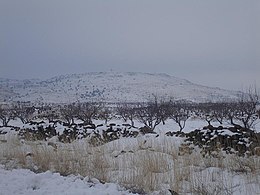This article includes a list ofgeneral references,butit lacks sufficient correspondinginline citations.(May 2016) |
Jabal al-Druze(Arabic:جبل الدروز,romanized:jabal al-durūz,lit. 'Mountain of the Druze'), is an elevated volcanic region in theAs-Suwayda Governorateof southernSyria.[1]Most of the inhabitants of this region areDruze,and there are also significantChristiancommunities.[2][3]Safaiticinscriptions were first found in this area. TheState of Jabal Druzewas an autonomous area in theFrench Mandate for Syria and the Lebanonfrom 1921 to 1936.[4][5]In the past, the name Jabal al-Druze was used for a different area, located inMount Lebanon.[citation needed]

In Syria, most Druze reside in theAs-Suwayda Governorate,which encompasses almost all of Jabal al-Druze. This governorate is unique in Syria as it has aDruzemajority. Additionally, it has integratedChristian communitiesthat have longcoexisted harmoniouslywith the Druze in these mountain.[6]
In the 1980s Druze made up 87.6% of the population, Christians (mostlyGreek Orthodox) 11% and Sunni Muslims 2%.[7]In 2010, the As-Suwayda governorate has a population of about 375,000 inhabitants,Druzemade up 90%,Christians7% and Sunni Muslims 3%.[2]Due to low birth and highemigration rates,Christians proportion in As-Suwayda had declined.[2]
Geology
editThe Jabal al-Druze volcanic field, the southernmost in Syria, lies in the Haurun-Druze Plateau in SW Syria near the border with Jordan. The most prominent feature of this volcanic field is 1800m-high Jabal al-Druze (also known variously as Jabal ad Duruz, Djebel Al-Arab, Jabal Druze, Djebel ed Drouz). The alkaline volcanic field consists of a group of 118 basaltic volcanoes active from thelower-Pleistoceneto theHolocene(2.6 million years ago to present). The large SW Plateau depression is filled by basaltic lava flows from volcanoes aligned in a NW-SE direction. This volcanic field lies within the northern part of the massive alkalineHarrat al-Sham(also known as Harrat al-Shaam) volcanic field that extends from southern Syria to Saudi Arabia.[8]
Peaks
edit- Tell Qeni (1,803 m)
- Tell Joualine (1,732 m)
- Tell Sleiman (1,703 m)
- Tell Qleib (1,698 m)
- Tell Abou-Hamra (1,482 m)
- Tell El-Ahmar (1,452 m)
- Tell Abed-Mar (1,436 m)
- Tell Khodr-Imtan (1,341 m)
- Tell Azran (1,220 m)
- Tell Shihan (1,138 m)
InArabic,the word "tell"means" mound "or" hill ", but in Jabal al-Druze it rather refers to avolcanic cone.
See also
editReferences
edit- ^"Mount al-Durūz | Lebanon, Anti-Lebanon Range, Summit | Britannica".britannica.Retrieved2024-07-22.
- ^abcThe Druze and Assad: Strategic Bedfellows
- ^"Christians in Syria's Suwayda discuss history, coexistence with Druze majority".North Press. 18 September 2020.
- ^"11. French Syria (1919-1946)".uca.edu.Retrieved2024-07-22.
- ^"French Mandate for Syria and the Lebanon".The American Journal of International Law.17(3): 177–182. 1923.doi:10.2307/2212963.ISSN0002-9300.JSTOR2212963.
- ^Balanche, Fabrice (2017).Atlas of the Near East: State Formation and the Arab-Israeli Conflict, 1918–2010.Brill. p. 27.ISBN9789004345188.
.. prised 50,328 inhabitants, of whom 85 per cent were Druze, and it integrated Christian communities (7,000 people) who had long lived in these mountains in harmony with the Druze.
- ^Pipes, Daniel (1990).Greater Syria: The History of an Ambition.Oxford University Press. p.151.ISBN978-0-19-506021-8.
- ^Krienitz, M.-S.; Haase, K. M.; Mezger, K.; Shaikh-Mashail, M. A. (August 2007)."Magma Genesis and Mantle Dynamics at the Harrat Ash Shamah Volcanic Field (Southern Syria)".Journal of Petrology.48(8). Oxford University Press: 1513–1542.doi:10.1093/petrology/egm028.Retrieved2024-07-22.